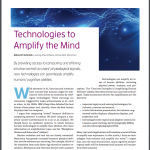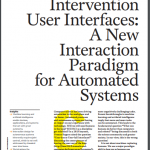Research Direction
In our group we conduct research at the crossroads of human computer interaction, media technology, and ubiquitous computing.
We are involved in different research projects, including European Projects (H2020) and nationally funded projects (DFG, BMBF).
Our research interests are in challenges that pose hard questions for basic research, but at the same time have a clear application to specific domains or impact on society.

The overall research question is: how can we enhance human abilities through digital technologies. In a recent IEEE Computer article we have outlined this vision of amplifying the human mind through digital technologies [1].
 With increasing automation and with autonomous systems becoming ubiquitous, the challenges for keeping the human in the loop and in the center becomes even greater and more important. We have suggested a novel interaction paradigm “Intervention user interfaces” to reflect this [2].
With increasing automation and with autonomous systems becoming ubiquitous, the challenges for keeping the human in the loop and in the center becomes even greater and more important. We have suggested a novel interaction paradigm “Intervention user interfaces” to reflect this [2].
Topics
Topics that we work on include:
-
- physiological sensing for human computer interaction (EMG, EEG)
- interfaces that adapt to the user’s cognitive load
- measuring and understanding cognitive load in the context of interactive systems
- interaction with automated and autonomous systems
- interaction with big data and interactive exploration of complex data
- augmented reality (AR) and its applications
- virtual reality (VR) and interaction in virtual reality, e.g. haptics in VR
- emotions in user interface
- accessibility of ubiquitous computing systems
- wearable computing user interfaces
- automotive user interface in the context of automated driving and with a focus on secondary tasks
Publications
To get an overview of our research, please have a look at our publications:
References
[1] A. Schmidt, “Technologies to Amplify the Mind,” (PDF) in Computer, vol. 50, no. 10, pp. 102-106, 2017. doi: 10.1109/MC.2017.3641644
[2] Albrecht Schmidt and Thomas Herrmann. 2017. Intervention user interfaces: a new interaction paradigm for automated systems. (PDF) interactions 24, 5 (August 2017), 40-45. DOI: https://doi.org/10.1145/3121357
